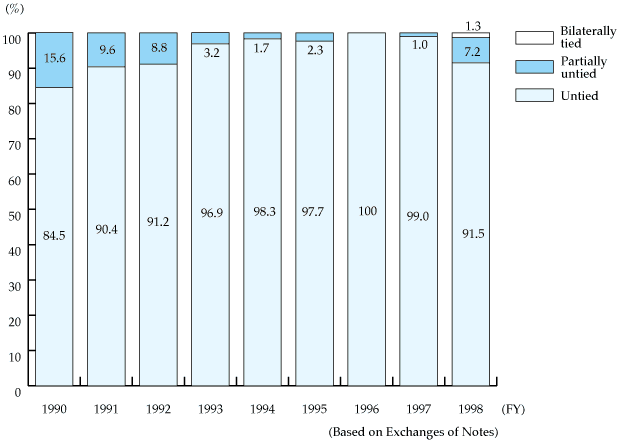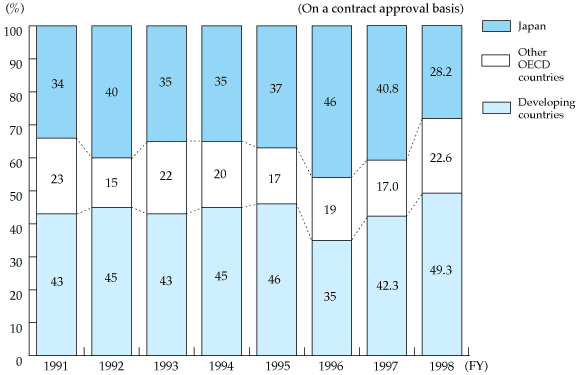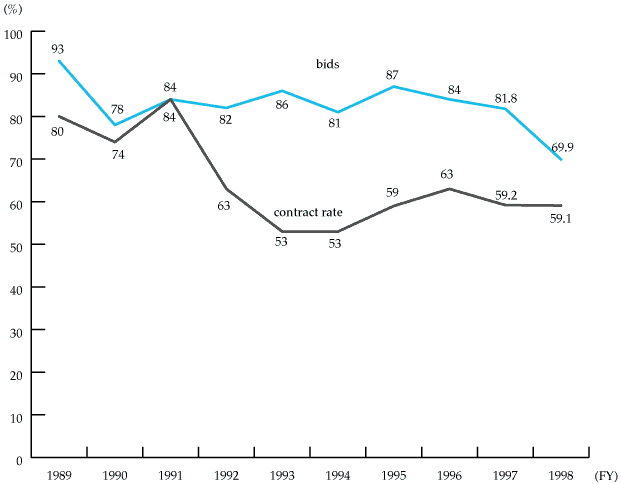Official Development Assistance (ODA)
Part IV. Issues Related to the Implementation and Management of ODA
Chapter 4 The Provision of More Efficient, Effective Aid
Section 4 Evaluations and Follow-up Assistance
To enhance the effectiveness of ODA, since 1981 the Japanese government and its aid agencies have been evaluating aid projects on a regular basis. ODA evaluations strive to determine whether aid projects have met their initial objectives or generated outcomes for development in the recipient developing country. Whenever the evaluation process reveals ineffectiveness or areas for improvement in projects, follow-up action will be taken. For example, the government of the recipient country may be recommended to take necessary remedial measures. However, if self-help efforts are not feasible, various other steps can be taken to ensure that the aid provided to date does not go to waste. These may include fresh follow-up projects, the dispatch of individual experts, or the supply of spare parts and other components for repair or maintenance purposes. Moreover, the findings and lessons derived from evaluation are fed back to policy makers and utilized in formulating future projects and their implementation. As such, ODA evaluations have become an indispensable element of the process for the implementation of more effective and efficient ODA projects.
To ensure the objectivity, neutrality, and reliability of evaluation, MoFA regularly commissions evaluation work to outside, private sector organizations and experts. Further, to broaden evaluation perspectives and schemes, it also pursues joint evaluations with recipient country personnel and with other donor countries and institutions. Evaluations often incorporate a comprehensive focus that examines the environmental or macroeconomic effectiveness not only of individual projects, but also of Japanese ODA undertakings at the sectional and country levels.
Since 1982, MoFA has disclosed the findings of ODA evaluations in the Annual Evaluation Report on Japan's Economic Cooperation,23 a document that provides the public with a detailed account of Japanese ODA realities and accomplishments. Issued in July 1999, the latest report discusses the findings of all evaluations performed in FY1997, with attention to 154 ODA projects in 59 countries. Beginning with the 1999 edition, an effort has been made to strengthen the comprehensive analytical value of the report by including the findings of JICA and JBIC evaluations in addition to those conducted by MoFA.
Section 5 The Utilization of Japanese Technology and Expertise
1. More Concessional Loan Terms for the Utilization of Japanese Technology and Expertise
Having worldwide access to suppliers of quality, inexpensive equipment, materials, and services helps recipient countries improve the efficiency of their aid. On that understanding, it is now Japanese policy to provide ordinary yen loans on an untied basis. (According to yen loan contract records, at least 90 percent of all yen loans have been provided on an untied basis since FY1991.) This policy has earned broad appreciation from developing countries and the international community at large.24
However, in some cases, it seems worthwhile that Japanese companies have more opportunities for participation in ODA projects, and that recipients be able to actively utilize the technologies and expertise at Japan's command. To accommodate such demand, Japan now provides yen loans for specific fields and objectives on a tied basis that is in accordance with international rules.
To strengthen its assistance for projects in the environmental field, human resources development, the promotion of small- and medium-sized enterprises, and consultant services, Japan, in September 1997 decided to significantly reduce the interest rates on yen loans, and applied terms of 0.75 percent interest with a 40-year repayment period (with 10-year grace period).25 In the interest of harnessing Japanese characteristics and providing aid in these fields with a stronger Japanese identity that citizens in recipient countries will be able to recognize, the government has been exploring ways of utilizing the technology and expertise of private Japanese companies. To that end, it decided in principle to tie procurement conditions, within internationally acceptable limits, for yen loan projects financed at more concessional terms, as follows: (i) partially untying (procurements from suppliers in Japan and developing countries) the provision of equipment and services (other than consultant services) for human resources development projects and environmental projects; and (ii) bilateral tying (procurements from suppliers in Japan and the recipient country) for consultant services.
Many Asian countries urgently need to implement economic structural reforms. To finance programs in the arena of structural reform, Japan in December 1998 announced the availability of special yen loan facilities26 on more concessional terms (initially set at 1 percent interest with a 40-year repayment period). Because the terms are in accordance with international rules for the provision of loans on a tied basis, the contractors of the projects provided by these special yen loans are in principle limited only to Japanese companies. This new scheme is intended to promote the utilization of Japanese technology and expertise, and to expand the opportunities for participation by Japanese companies that can be expected to contribute significantly to Asia's economic recovery.
In recent years, it has been asserted that Japanese companies win only a small percentage of the total in contracts for yen loan projects. The basis for this claim is the average 30 percent contract rate for the past five years. However, if one excludes local currency costs (of little interest to Japanese companies, and comprising wages for local country workers and the cost of materials procured locally), which account for 30 percent of the total in yen loans, it turns out that Japanese companies actually receive the equivalent of 40 to 50 percent of the available ODA contract total in value terms. Another point worth noting is that Japanese companies bid for about 80 percent of all large-scale contracts (those worth at least ¥1 billion) and tender the winning bid in about 60 percent of those cases. In FY1998, Japanese companies tendered bids for fewer projects of this scale: about 70 percent of the total. This drop, however, was due to a year-on-year reduction in the scale of approved contract sums for projects in those sectors where Japanese contractors customarily enjoy a high contract rate-e.g., supplies of equipment and facilities, transportation, and electric power generation.
2. Issue of Untying ODA to Least-Less Developed Countries (LLDCs)
DAC has been debating the issue of untying ODA to LLDCs. (In this context, "untied" means freeing the recipient to procure aid-related materials and services from any country.) Implementing aid projects on a more effective and efficient basis is the principal objective behind the notion of untying. Japan has already made considerable progress in untying; in 1996, 98.9 percent of all Japanese ODA was untied except for technical cooperation.
The debate over untying was initiated at a High Level Meeting (HLM) of DAC in April 1998. On that occasion, it was agreed that the Working Party on Financial Aspects (WP/FA) work on a Recommendation on Untying ODA to LLDCs, with a view to presenting a proposed text to the HLM in 1999. Although the issue was subsequently addressed over the intervening year at the WP/FA as well as by various DAC meetings, including the Senior Level Meeting (SLM), the May 1999 DAC HLM was unable to reach a consensus on the issue. Consequently, debate will be sustained into the year 2000.
Japan has argued that all forms of technical cooperation, including investment related technical cooperation (technical cooperation relating to project or procurement preparation) should be excluded from the coverage of a recommendation. The reason is that: technical cooperation has the objective of transferring a technology peculiar to each donor country, and as such, aid visibility is particularly important. Secondly, as to procurement regimes, Japan insists that the flexibility should be secured to take into account the requests and capacities of partner countries as well as the institutional structures of each donor country. Moreover, Japan has maintained that donor countries with a lower level of untying should first to make additional efforts in untying their ODA.
- See Box 5 in Part II, Chapter 1, Section 5 Information Disclosure and Development Education.
- To avoid causing trade distortion due to public export credit or aid credit, OECD export credit arrangements require that tied ODA loans be offered at terms better than those available with commercial loans. At present, these criteria are satisfied only by the terms offered on special yen loans (1 percent interest and a 40-year repayment period, including a 10-year grace period) and more concessional terms on yen loans for selected projects in environmental fields, human resources development, the cultivation of small- and medium-sized enterprises, and consultant services (0.75 percent interest and a 40-year repayment period, including a 10-year grace period).
- The scope of eligibility (middle-income countries are ineligible) for yen loans on the most concessional terms (0.75 percent interest with a 40-year repayment period, inclusive of a 10-year grace period) is as follows:
(i) Environmental projects to address pollution and global environmental issues such as global warming; (ii) Human resources development projects such as student exchange and training programs in Japan, dispatch of Japanese experts abroad, as well as the facilities required for these purposes; (iii) A low-interest financing system for small- and medium-sized enterprises (however, with procurement terms untied, given the nature of two-step loans); (iv) Consultant services for projects requiring an environmental focus. - See Part II, Chapter 2, Section 1 Towards Economic Recovery in Asia. Japan established a special framework for the provision of up to ¥600 billion in yen loans over the next three years as assistance for infrastructure projects conducive to economic stimulus, job creation, and reforms in economic structure.



